Fish and shrimp are not the only professional aquarium cleaners. The keeping of freshwater aquarium snails is gaining popularity every year. Many species actively consume algae, helping to destroy their population in the aquarium. And they often have a stunning appearance, from which it is difficult to take your eyes off. Our article will focus on horned snails – an amazing combination of beauty and benefits.
General information
Freshwater mollusks from the genus Clinton, which are part of the Neritina family, are commonly called horned snails. The invertebrates got their name for the characteristic spines on the shell, which serve as a means of protection for them. At the same time, they give the snails a special charm, which, together with their beautiful coloration, made these snails so popular among hobbyists.
Horned snails are not only beautiful but also useful. Their diet is based on various types of algae. Therefore, if your tank has problems with lower plants, snails will help solve them. At the same time, they do not harm higher plants even with small leaves, effectively cleansing them of unexpected guests. It is noted that mollusks do an excellent job with xenocokus, although even manually removing it from glass is quite problematic. The small size of the horned snails allows them to climb into places where other species, such as algae-eating fish, cannot climb. It also allows you to keep shellfish even in nano aquariums.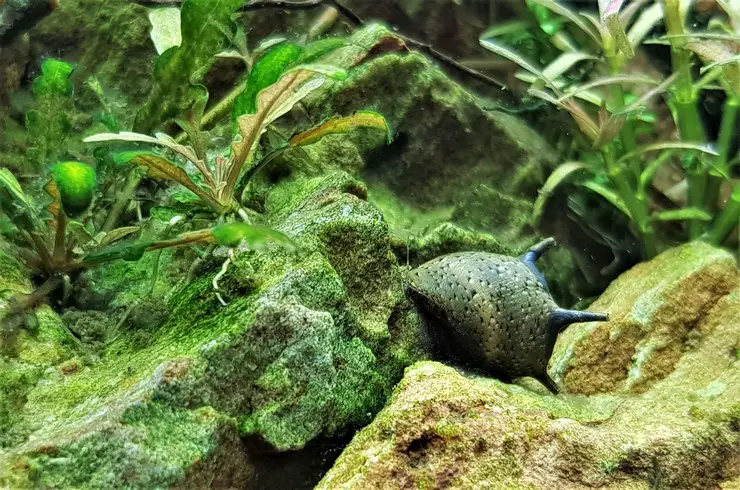
Horned snails do not breed in freshwater, so, unfortunately, it will not be possible to breed their offspring. On the other hand, there is no need to control the number of snails in the aquarium.
Appearance
The shells of horned snails are in the shape of a sphere or egg with 3-4 coils. A distinctive feature is the presence of sharp spines of different lengths on the shell. They are located in different places without any regularity and help their mistresses to defend themselves from predators. In no case try to clench the snail in your fist, it will be painful. The thorns break off quite easily, which does not harm the horned snails. They often break during transportation. An interesting fact is that in some individuals the thorns grow in proportion to the growth of the body, and in some, they remain at the same level all their lives.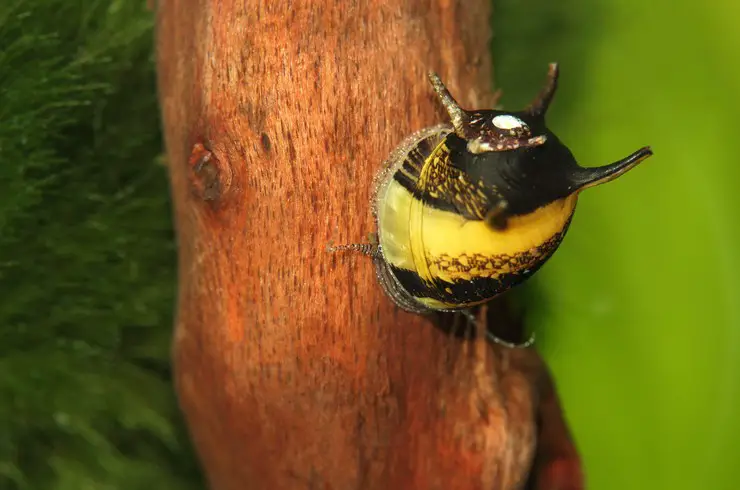
The shell size of horned snails does not exceed 2 cm. Therefore, they do not need a large aquarium. This also allows them to stick to even the smallest leaves of plants. The operculum (the lid covering the entrance to the shell) is orange-brown with a yellowish spot in the middle.
The color of mollusks is varied; yellowish-green, yellow-black, and gray-yellow colors prevail. There are several contrasting dark stripes. Gender dimorphism is not pronounced. One of the color variations with alternating bright yellow and black stripes in our country is called the “Beeline” snail, for its resemblance to the logo of a well-known mobile operator.
Habitat
Horned snails have a fairly wide range, including the countries of East and Southeast Asia: Japan, China, Thailand, the Philippines, Indonesia.
Adult snails inhabit numerous lagoons and small rivers with sandy or rocky bottoms. The larvae develop only in the saltwater of the seas, after which they return back to the rivers.
Care and maintenance
The minimum recommended volume for a horned snail aquarium starts at 10 liters. Clams are best kept in groups of 5 or more. These gastropods are renowned for their love of adventure overland, so be sure to cover your tank with a coverslip or lid. Although escaping from the container is often caused by poor conditions of detention or hunger.
The ground and decorations in the aquarium do not play any role, you can choose them according to your taste. Horned snails get along well with living plants, so they can be safely kept in herbalists.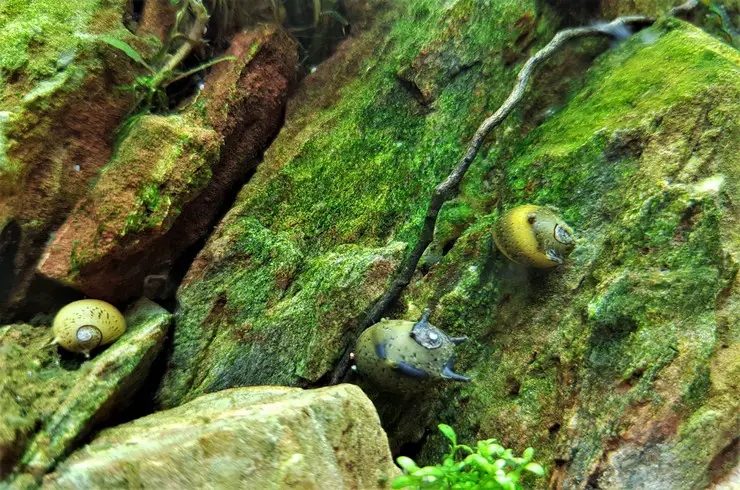
It is recommended to provide high-quality filtration and aeration, which will maintain the purity of the water, which directly affects the well-being of the snails.
In soft and acidic water in horned snails, the shell can collapse, therefore it is necessary that the water has a hardness of at least 10 DH and acidity of at least 7 units. The comfortable temperature will be 24-26 ° С. In cool water, the activity of snails decreases sharply.
Compatibility
You can keep horned snails in a shared aquarium with peaceful species of fish, shrimps, and other snails.
In neighbors, it is best to choose small species – zebrafish, tetras, guppies, neons, etc. Cohabitation with large predators is best avoided, in some cases even sharp thorns do not save the snail.
Fish that feed on snails are not suitable for joint keeping – tetrapods, battles. Sometimes bettas and gourami show interest in mollusks. Avoid combining with predatory Helen snails, which can easily suck a small mollusk from its shell.
Horned snail feeding
Horned snails feed on algae. In a matter of days, they can clean aquarium glass, soil, and decorations. However, shellfish should be regularly fed with high quality, plant-based dry food such as Tetra Pleco Spirulina Wafers. But the benefits of these pills are not only high in nutritional value. They are ways to quickly sink to the bottom and maintain their shape for a long time until the snails deal with them.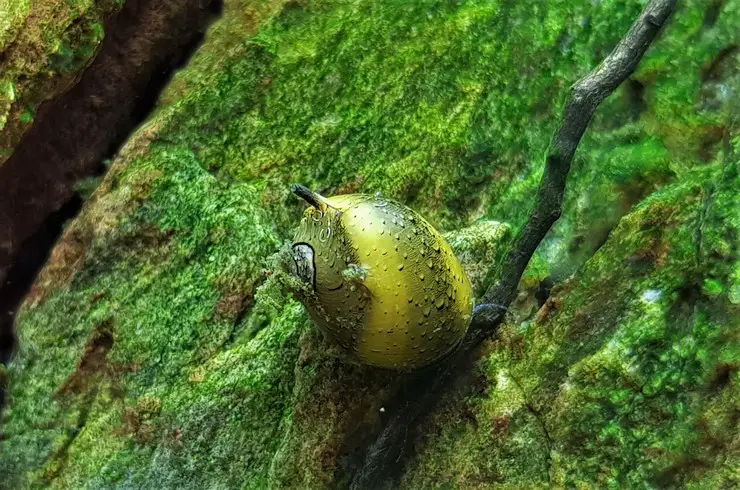
Reproduction and breeding
Reproduction of horned snails at home is a rather complicated process because the larvae need saltwater for proper development.
There are no external differences between the male and the female, so it is best to keep a group of snails. From time to time, the female will lay eggs, which, by the way, are very difficult to remove, on anything that comes along her way: glass, decorations, plants.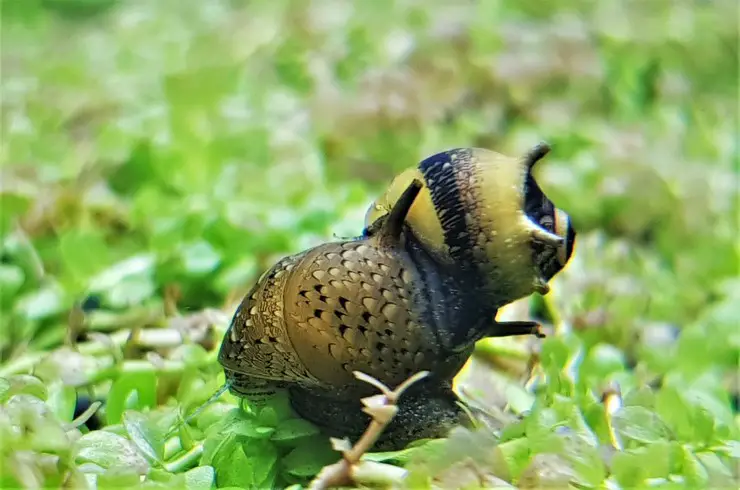
Even successful breeding attempts in private aquariums led to the death of the offspring. Most of the horned snails are supplied to us from the countries of Southeast Asia, they are caught in the wild.

